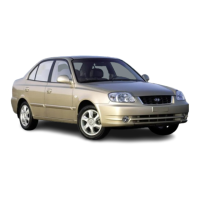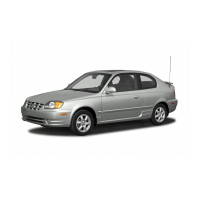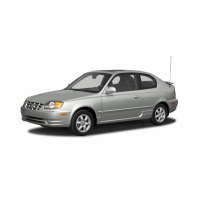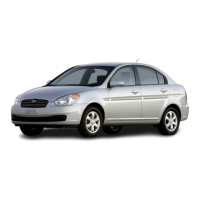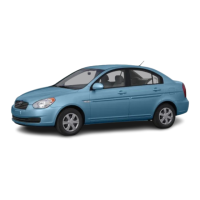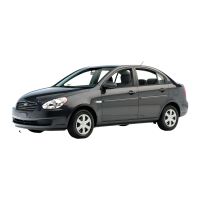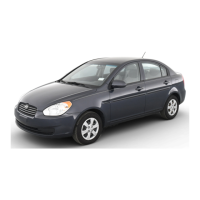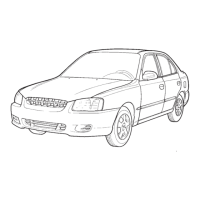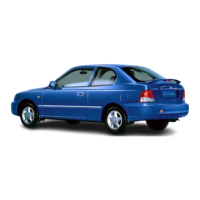Do you have a question about the Hyundai 2000 Accent and is the answer not in the manual?
Covers the driving and operation of your Hyundai vehicle.
Details on required maintenance procedures and schedules.
Technical specifications for your Hyundai vehicle.
Indicates conditions that may result in harm or injury.
Indicates conditions that may result in damage to your vehicle.
Provides interesting or helpful information.
Overview of your Hyundai's features and operation.
Guidelines for selecting the correct fuel for your vehicle.
Information on using gasohol (ethanol blend) in your vehicle.
Warning against using fuel containing methanol.
Recommendation for using detergent additives in gasoline.
Considerations for operating your Hyundai abroad.
Recommendations for the first 2,000 km (1,200 miles) of driving.
Information about your vehicle's keys and their usage.
Details on the anti-theft immobilizer system.
How to record and use your key numbers for replacement.
Steps to follow if the immobilizer system prevents starting.
Explanation of the vehicle's theft alarm system.
Instructions on how to arm the theft-alarm system.
Description of when the alarm is activated.
Instructions on how to disarm the theft-alarm system.
Operation of the panic alarm feature.
How to lock doors using the keyless entry transmitter.
How to unlock doors using the keyless entry transmitter.
Safety warning regarding unlocked doors and their potential hazards.
Instructions for locking and unlocking doors using the key.
How to lock doors from the inside using the lock switch.
Operation of the child-protector lock for rear doors.
Warning about securing luggage or cargo in the rear seat.
Information on adjusting front seats for comfort and safety.
Critical safety warning against adjusting seats while driving.
Instructions for adjusting the seat's fore and aft position.
Instructions for adjusting the seatback recline angle.
Information on adjusting headrests for safety and comfort.
Safety warning on proper headrest adjustment for crash protection.
How to adjust the lumbar support on the driver's seat.
How to adjust the height of the driver's seat cushion.
Operation of the front seat warmer system.
Procedure for accessing the rear seat in 3-door models.
Safety warning regarding rear seat passenger interaction with front seat controls.
Operation of manual window glass controls.
Operation of the power window system.
Critical safety warning about closing power windows.
Operation of the central door locking system.
Essential safety information regarding seat belt usage.
Recommendations for child restraint systems for infants.
Recommendations for seat belt usage by larger children.
Safety advice for pregnant women using seat belts.
Advice for using seat belts with injured persons.
Warning against multiple occupants sharing a single seat belt.
Safety advice on passenger seating positions.
Critical safety warning about reclined seating positions while driving.
Instructions for maintaining and inspecting seat belts.
Recommendation for periodic inspection of seat belt systems.
Guidelines for cleaning seat belts properly.
Criteria for replacing seat belt assemblies after an accident.
How to adjust the shoulder belt anchor for optimal safety.
Critical safety warning about securing the height adjuster.
Detailed information on the driver's 3-point seat belt system.
Step-by-step instructions for fastening the seat belt.
Instructions for properly adjusting the seat belt.
Instructions for releasing the seat belt.
Information on the rear seat center 2-point seat belt.
Instructions for fastening the 2-point static seat belt.
How to adjust the length of the 2-point static seat belt.
Instructions for releasing the 2-point static seat belt.
Critical warning about correct buckle usage for rear seat belts.
Information and requirements for child restraint systems.
Critical safety warning about child seat placement due to airbags.
Guidance on selecting child seats based on vehicle seating positions.
General instructions for using child restraint systems.
Location of anchor points for child restraint systems in 4-door models.
Location of anchor points for child restraint systems in 3/5-door models.
Procedure for installing child restraints in outboard rear seats.
Important note regarding child restraint system installation instructions.
Critical safety warning against front seat child restraint installation.
Explanation of the pre-tensioner seat belt system without airbags.
Informational note about the noise generated by pre-tensioner activation.
Critical safety warning against DIY replacement of pre-tensioner seat belts.
Explanation of the pre-tensioner seat belt system with airbags.
Critical safety advice for maximizing pre-tensioner seat belt effectiveness.
Operational caution regarding SRS airbag sensor and warning light.
Critical safety warning about malfunctioning SRS airbag warning lights.
Details on the Supplemental Restraint (Airbag) System.
Critical safety warning about SRS system limitations and seat belt usage.
Specific caution regarding placement of air fresheners near vehicle electronics.
Safety warning about normal conditions during SRS activation (noise, dust).
Critical safety warning for side airbag system usage and occupant posture.
Critical safety warning about child restraints and front airbags.
Specific caution regarding placement of air fresheners near vehicle electronics.
Overview of the vehicle's instrument cluster and warning indicators.
Function of the overdrive off indicator for automatic transmissions.
Explanation of the turn signal indicator lights.
Warning light for the Anti-lock Braking System.
Indicator light for the high beam headlights.
Warning light indicating seat belt status.
Critical warning light for low engine oil pressure.
Critical safety/operational warning about low oil pressure.
Warning light for parking brake and brake fluid level.
Critical safety caution regarding brake system issues.
Explains the normal operation of the parking brake/brake fluid warning light.
Operational caution for towing-related overheating.
Warning light indicating a door is not fully closed.
Indicator light warning when the fuel tank is approaching empty.
Warning light for the Supplemental Restraint (Airbag) System.
Audible warning for worn brake pads.
Warning light for exhaust system or engine malfunctions.
Audible alert for specific conditions, like lights left on.
Instrument indicating the current fuel level in the tank.
Instrument indicating the engine coolant temperature.
Critical safety warning about removing a hot radiator cap.
Instrument indicating the vehicle's speed.
Records total driving distance for maintenance tracking.
Warranty caution regarding odometer tampering.
Instrument for recording specific trip distances.
Instrument indicating engine speed in revolutions per minute.
Critical operational caution against over-revving the engine.
Overview of the multi-function switch for lights and signals.
How to operate the turn signal indicators.
How to use the lane change signal function.
How to operate the headlight controls.
How to flash the headlights.
Information on the daytime running lights system.
How to operate the high-beam headlights.
Overview of the windshield wiper and washer controls.
Operational note regarding wiper system care and heavy snow/ice.
How to operate the windshield washer system.
How to operate the wipers for mist conditions.
How to adjust the intermittent wiper speed.
Operation of the rear window wiper and washer system.
Operation of the hazard warning lights.
How to operate the rear window defroster.
Caution regarding cleaning the rear window glass to avoid damage.
Operational note for the rear window defroster.
How to operate the front fog light switch.
How to operate the rear fog light switch.
How to set and operate the digital clock.
How to use the cigarette lighter accessory.
Operation and cleaning of the front ashtray.
Operation and cleaning of the rear ashtray.
Location and use of the drink holder.
Operational caution for the drink holder's storage.
Safety warning against placing objects on the drink holder.
Instructions for removing the sunshade.
Instructions for tilting the sunroof upwards.
Instructions for closing the sunroof.
Critical safety warning about closing the sunroof with obstructions.
Operational caution regarding sunroof use in adverse weather.
Instructions for removing the sunroof.
Critical safety warning against installing/removing sunroof while driving.
Instructions for installing the sunroof.
Storage caution regarding the sunroof bag contents.
Advice on properly storing the sunroof and sunshade.
Operation of the interior courtesy light with sunroof.
Operation of the interior courtesy light without sunroof.
Location and operation of the glove box.
Safety warning to keep the glove box door closed while driving.
Operation of manual outside rear view mirrors.
Operational caution for frozen mirror controls.
Operation of electric outside rear view mirrors.
Operational caution regarding continuous use of mirror controls.
Safety warning about judging distances in convex passenger mirrors.
Operation of the outside rearview mirror heating system.
Instructions for folding the outside rearview mirrors.
Critical safety warning against adjusting/folding mirrors while driving.
Operation of the day/night feature for the inside rearview mirror.
How to engage and release the parking brake.
Information on folding rear seat backs for cargo.
Safety warning regarding the use and limitations of folded rear seats.
Operation and securing of the tail gate and trunk lid.
Safety warning about keeping the tail gate/trunk lid securely closed.
Information on the cargo area cover in 3/5-door models.
Operation of the trunk lid emergency latch release.
Informational note about the trunk lid emergency release lever.
How to operate the remote tail gate/trunk lid release.
Information on the high-mounted rear stop light.
How to operate the remote fuel-filler lid release.
Operational note for frozen fuel-filler lids.
Critical safety warning about gasoline vapors and refueling.
How to open the vehicle's hood.
Critical safety warning about closing the hood properly.
Information on the function and use of sun visors.
Informational note about the SRS label location on sun visors.
Operational caution regarding sun visor placement and visibility.
How to adjust the steering wheel tilt.
How to use the horn with the steering wheel airbag.
How to use the horn without the steering wheel airbag.
How to select the blower fan speed.
How to select fresh outside or recirculated inside air.
Operational note regarding potential windshield misting with heating.
How to direct the flow of air through different vents.
Air discharged through face level vents.
Air discharged through face and floor vents simultaneously.
Air discharged through the floor vents.
Air discharged through defrost vents and floor vents.
Air discharged through windshield defrost vents.
How to select the degree of heating desired.
Controls for the heating system operation.
How to use bi-level heating for simultaneous cool/warm air.
How to operate the ventilation system.
Location and adjustment of center air vents.
Location and adjustment of side air vents.
Tips for operating the heating/cooling system effectively.
How to turn the air conditioning system on and off.
How to use the air conditioning for cooling.
How to use the air conditioning for dehumidified heating.
General tips for operating the air conditioning system.
Maintenance caution for the air filter replacement interval.
Explanation of how FM radio signals are received.
Explanation of how AM radio signals are received.
Explanation of FM signal fading and how to mitigate it.
Explanation of FM flutter/static and potential causes.
Explanation of how the radio swaps between stations.
Explanation of multi-path interference in radio signals.
Caution regarding the use of communication systems and potential interference.
Operation of the power, volume, and balance controls.
Operation of the fader control for speaker balance.
Operation of the bass and treble tone controls.
How to manually select radio frequencies.
How to select between AM, FM1, and FM2 radio bands.
How to select preset radio stations.
Operation of the power, volume, and balance controls.
Operation of the balance control for speaker balance.
Operation of the fader control for front/rear speaker balance.
How to adjust the bass tone control.
How to adjust the treble tone control.
How to select between AM, FM1, and FM2 radio bands.
How to manually select radio frequencies.
How to automatically scan for radio stations.
How to select preset radio stations.
Step-by-step guide for programming preset radio stations.
Operation guide for the H900A stereo radio and cassette player.
Operation of the tune and seek select buttons.
How to select between AM, FM1, and FM2 radio bands.
How to select preset radio stations.
Operation of the bass and treble tone controls.
Operation of the power, volume, and balance controls.
Operation of the fader control for speaker balance.
How to eject a cassette tape.
How to use the tape program function.
Operation of the power, volume, and balance controls.
Operation of the balance control for speaker balance.
Operation of the fader control for front/rear speaker balance.
How to adjust the bass tone control.
How to adjust the treble tone control.
How to manually select radio frequencies.
How to automatically scan for radio stations.
How to select between AM, FM1, and FM2 radio bands.
How to select preset radio stations.
Step-by-step guide for programming preset radio stations.
How to use the tape program function for fast wind.
Operation of the bass and treble tone controls.
How to select preset radio stations.
Operation of the tune and seek select buttons.
How to select between AM, FM1, and FM2 radio bands.
Operation of the fader control for speaker balance.
Operation of the power, volume, and balance controls.
Operation of the power, volume, and balance controls.
How to adjust the volume level.
Operation of the balance control for speaker balance.
Operation of the fader control for front/rear speaker balance.
How to adjust the bass tone control.
How to adjust the treble tone control.
How to select between AM, FM1, and FM2 radio bands.
How to manually select radio frequencies.
How to automatically scan for radio stations.
How to select preset radio stations.
Step-by-step guide for programming preset radio stations.
How to stop CD playback or switch to radio.
How to fast forward or rewind through tracks.
How to select the next or previous track.
How to repeat the current music track.
How to eject a CD from the player.
Operational notes for the CD player, including temperature and fuse replacement.
Guidelines for handling discs to prevent damage.
Advice on handling discs that are damaged or warped.
Recommendations for storing discs to protect them.
Instructions for cleaning discs to ensure proper playback.
Handling note for cassette tapes before insertion.
Information on the fixed rod antenna.
Caution for automatic car washes regarding antenna removal.
Information on the manual antenna.
Note regarding antenna retraction for car washes or low clearances.
Operation of the power antenna system.
Note regarding safety when operating the power antenna.
Critical safety warning about the dangers of engine exhaust fumes.
Warning against inhaling exhaust fumes due to carbon monoxide risk.
Importance of checking the exhaust system for leaks.
Safety warning about operating the engine in enclosed or poorly ventilated areas.
Safety advice on idling the engine with occupants inside.
Instructions for driving with the rear hatch or trunk open.
Pre-driving checks to perform before starting the engine.
Explanation of the ignition switch positions and functions.
Step-by-step procedure for starting the engine.
Operational note regarding safety interlocks for starting the engine.
Description of the ignition key positions (LOCK, ACC, ON, START).
Critical safety warning about ignition key removal while driving.
Note on unlocking the steering wheel with the ignition key.
Procedure for starting the engine on carburetor models.
Standard steps for starting the engine.
Starting procedure specifically for a cold engine.
Starting procedure for a warm engine.
Procedure for starting an engine that may be flooded.
Note on warming up the engine in severe weather conditions.
Emergency procedure if the engine stalls while driving.
Critical safety warning about running the engine in enclosed areas.
Explanation of how to operate the manual transaxle.
Proper technique for using the clutch pedal.
General advice for safe and efficient driving.
Critical driving safety advice against coasting downhill.
Driving caution against resting the foot on the brake pedal.
Driving advice to prevent engine damage when downshifting.
Critical safety warning about the risk of rollover at high speeds.
Recommended speeds for shifting gears for fuel economy.
Critical transmission caution against shifting into Park or Reverse while moving.
Transmission operation note for shifting.
Explanation of the automatic transaxle and its functions.
Description of each gear selector lever position.
Explanation of the Park position for the transmission.
Critical transmission caution against engaging Park when moving.
Explanation of the Reverse position for the transmission.
Explanation of the Neutral position for the transmission.
Explanation of the Drive position for normal driving.
Explanation of the 2nd gear position for specific driving conditions.
Explanation of the Low gear position for steep grades or engine braking.
Transmission operation note regarding brake pedal usage during shifting.
Critical transmission caution against engaging Reverse or Park when moving.
General advice for safe and efficient driving.
Critical driving safety advice on using the footbrake during shifting.
Driving caution against relying solely on Park for braking.
Maintenance advice for checking automatic transaxle fluid.
Critical driving caution against accelerating with brakes applied.
Critical safety warning about the risk of rollover at high speeds.
General advice for safe and efficient driving.
Critical driving safety advice against shifting with accelerator depressed.
Critical driving safety advice against engaging Park while moving.
Critical driving safety advice for shifting into Reverse.
Critical driving safety advice against coasting downhill.
Driving caution against resting the foot on the brake pedal.
Driving advice to prevent engine damage when downshifting.
Driving advice to always use the parking brake.
Driving advice for exercising caution on slippery surfaces.
Driving advice for fuel economy and smooth performance.
Critical safety warning about the risk of rollover at high speeds.
Explanation of the Anti-Lock Brake System and its function.
Note on ABS operation characteristics and feel.
Tips for improving fuel economy while driving.
Critical safety warning about ABS limitations and driving behavior.
Information on ABS braking distances in specific road conditions.
Advice on increased maintenance frequency for severe driving conditions.
Importance of keeping the car clean to prevent corrosion.
Advice on reducing vehicle weight for better fuel economy.
Advice on reducing fuel consumption by minimizing idling.
Information that Hyundai vehicles do not require extended engine warm-up.
Driving advice to prevent engine damage from lugging or over-revving.
Advice on using air conditioning sparingly for fuel economy.
Driving technique for cornering smoothly to minimize tire wear.
General advice and precautions for driving in winter conditions.
Specific advice for driving in snowy or icy conditions.
Informational note regarding provincial laws on tire chains.
Recommendation for using high-quality ethylene glycol coolant.
Advice on checking the battery and cables during winter.
Recommendation for using lower viscosity oil in cold weather.
Instructions for checking spark plugs and the ignition system.
Methods for preventing vehicle locks from freezing.
Note on the operating temperature range for the immobilizer key.
Recommendation for using approved anti-freeze in the washer system.
Caution regarding the parking brake freezing in icy conditions.
Caution regarding ice and snow buildup affecting steering.
Recommendations for carrying essential emergency equipment.
Advice and considerations for driving at high speeds.
Essential pre-trip checks before high-speed driving.
Importance of using headlights for visibility and safety.
General advice and legal requirements for towing.
Critical towing caution regarding the initial break-in period.
Selecting the proper hitch and ball combination for towing.
Caution regarding the selection and installation of trailer hitches.
Requirements for trailer braking systems.
Informational note regarding trailer braking system conformity.
Critical towing caution against direct connection of trailer brakes.
Importance and requirement of safety chains for towing.
Specifications for trailer weight limits.
Towing advice on proper load distribution within the trailer.
Caution regarding trailer towing specifications and loaded weight.
Critical towing safety warning about improper loading affecting vehicle dynamics.
Practical tips for towing trailers or vehicles.
Critical caution for actions to take if overheating occurs during towing.
Maintenance note for checking transaxle fluid when towing.
Emergency procedures for when the engine fails to start.
Critical starting caution against push or pull starting.
Troubleshooting steps for a slow or non-cranking engine.
Troubleshooting steps for an engine that cranks but doesn't start.
Emergency procedure if the engine stalls during operation.
Procedure for jump-starting a vehicle's battery.
Critical safety warning about explosive battery gases during jump-starting.
Emergency procedure if the engine overheats.
Critical safety warning about moving engine parts while the engine is running.
Information about the vehicle's spare tire.
Instructions for properly handling the spare tire.
Procedure to follow if a tire becomes flat while driving.
Step-by-step guide for changing a flat tire.
Step 1: Locating and retrieving the spare tire and tools.
Step 2: Blocking the wheel diagonally opposite the flat tire.
Step 3: Loosening the wheel nuts before raising the vehicle.
Step 4: Positioning the jack correctly under the vehicle.
Step 5: Instructions for safely raising the vehicle with the jack.
Critical safety warning against getting under a vehicle supported only by a jack.
Step 6: Removing the flat tire and installing the spare.
Step 7: Reinstalling the wheel nuts after mounting the spare tire.
Safety warning about potential hazards from wheel covers.
Step 8: Lowering the vehicle and properly tightening wheel nuts.
Post-tire change checks and securing equipment.
Procedures and precautions for towing your vehicle.
Critical caution regarding potential damage from incorrect towing.
Specific instructions for towing vehicles with manual transaxles.
Towing condition: vehicle is undamaged and has automatic/manual transaxle.
Specific instructions for towing vehicles with automatic transaxles.
Towing restriction for automatic transaxle vehicles in certain configurations.
Towing condition for manual transaxle vehicles.
Critical towing caution against towing automatic transaxles rear-first with front wheels on ground.
Procedure for emergency towing when commercial services are unavailable.
Procedure to follow if you lose your vehicle keys.
Owner's role in maintaining long-term corrosion resistance.
Identifies common factors that lead to vehicle corrosion.
Factors contributing to corrosion in specific environmental areas.
Explains how moisture accelerates corrosion processes.
Recommendations for preventing corrosion from starting.
The most effective method to prevent corrosion is keeping the car clean.
Guidelines for washing and waxing your Hyundai.
Instructions on how to properly wash your vehicle.
Special precautions for maintaining the appearance of bumpers.
Precautions for bumper care, especially avoiding paint booth exposure.
General instructions for cleaning the vehicle's interior.
How to clean vinyl upholstery surfaces.
How to clean leather upholstered surfaces.
How to clean the vehicle's carpets using foam cleaners.
Instructions for cleaning and inspecting seat belts.
How to clean vehicle windows, including rear defroster caution.
Information on where to seek further assistance for car care.
Overview of when maintenance procedures should be performed.
Owner's responsibility for performing maintenance to comply with warranties.
Categorization of required vehicle maintenance tasks.
Details on maintenance tasks performed at specific intervals.
Daily checks recommended for vehicle operation.
Information for owners who wish to perform maintenance themselves.
Helpful tips related to vehicle servicing and warranty.
Specific requirements for scheduled vehicle maintenance.
Details on engine oil and filter change intervals and requirements.
Inspection and replacement guidelines for drive belts.
Information on fuel filter function, replacement, and potential issues.
Inspection and replacement guidelines for fuel system hoses.
Inspection and replacement guidelines for the timing belt.
Inspection guidelines for vapor hose and fuel filler cap.
Inspection guidelines for vacuum and ventilation hoses.
Recommendation for using genuine Hyundai air cleaner filters.
Guidelines for selecting and installing spark plugs.
Reference to specifications for basic ignition timing.
Procedure for checking and adjusting idle speed and CO.
Inspection of cooling system components for leaks or damage.
Guidelines for changing engine coolant at specified intervals.
Inspection of manual transaxle oil according to the maintenance schedule.
Note on checking for leaks before adding manual transaxle oil.
Automatic transaxle fluid level check and fluid type recommendations.
Critical maintenance warning about checking hot transaxle fluid.
Procedure for checking the automatic transaxle fluid level.
Specifications for recommended automatic transaxle fluid.
The fluid capacity of the automatic transaxle.
Procedure for changing the automatic transaxle fluid.
Procedure for checking the manual transaxle oil level.
Step-by-step guide to checking the transaxle fluid level.
Diagram and identification of components in the engine compartment.
DIY caution regarding careful handling of tools and engine components.
DIY caution regarding careful handling of tools and engine components.
DIY caution regarding careful handling of tools and engine components.
Daily checks for engine compartment items.
Monthly checks for vehicle exterior condition and components.
Checks to perform each time the vehicle is driven.
Specifications for recommended engine oil types.
Note regarding the limitation of SAE 5W-20 oil for high-speed driving.
Procedure for checking the engine oil level.
Procedure for adding engine oil.
Explanation of normal engine oil consumption.
Describes the primary functions of engine oil.
Factors affecting normal engine oil consumption.
Step-by-step guide for changing engine oil and filter.
Critical maintenance warning about the high temperature of draining engine oil.
Procedure for checking and changing engine coolant.
Critical maintenance warning about removing a hot radiator cap.
Specifications for recommended engine coolant and antifreeze mixture.
Procedure for checking the engine coolant level.
Procedure for changing the engine coolant.
Maintenance caution regarding engine coolant spills on vehicle finish.
Step-by-step guide for replacing spark plugs.
Specifications for recommended spark plugs (unleaded and leaded).
Procedure for changing spark plugs, including safety precautions.
Critical maintenance warning about changing spark plugs on a cool engine.
Step-by-step guide for changing the air cleaner filter.
Critical maintenance caution about operating without an air filter.
Inspection and cleaning instructions for windshield wiper blades.
Maintenance caution about operating wipers on dry glass.
Procedure for filling the windshield washer fluid reservoir.
Maintenance caution against using radiator antifreeze in the washer system.
Procedure for checking the manual transaxle oil level.
Step-by-step guide to checking the transaxle fluid level.
Procedure for changing the automatic transaxle fluid.
Specifications for recommended automatic transaxle fluid.
The fluid capacity of the automatic transaxle.
Critical maintenance warning about checking hot transaxle fluid.
Step-by-step guide to checking the transaxle fluid level.
Safety warning regarding the electric cooling fan's operation.
Importance of having brakes checked and inspected by a dealer.
Caution emphasizing professional inspection of the brake system.
Procedure for checking the brake fluid level.
Caution when handling brake fluid due to its corrosive nature.
Specification for the recommended brake fluid (DOT 3).
Procedure for checking the brake fluid reservoir level.
Procedure for adding brake fluid to the reservoir.
Caution when handling brake fluid, emphasizing avoiding eye contact and contamination.
Procedure for checking the clutch fluid level.
Instructions for replacing brake fluid, including fluid type.
Note warning against contaminating brake fluid with other liquids.
Caution when handling brake fluid due to its corrosive nature.
Guidelines for maintaining the air conditioning system.
Instructions for cleaning the air conditioner condenser and radiator.
How to check the tension and condition of the compressor drive belt.
Caution regarding potential compressor damage from low refrigerant.
Procedure to check the air conditioning system's cooling performance.
Importance of running the air conditioner periodically for lubrication.
Procedure to check for excessive freeplay in the steering wheel.
Procedure to check for freeplay in the brake pedal.
Procedure to check for freeplay in the clutch pedal.
Procedure to check the brake pedal clearance with a helper.
How to check drive belts for tension, wear, and routing.
Procedure for checking and replacing vehicle fuses.
Information about fusible links and precautions for replacement.
Critical caution against using incorrect amperage fusible links.
Procedure for replacing accessory fuses in the fuse box.
Caution regarding electrical circuit problems indicated by blown fuses.
Precautions and procedures for checking the vehicle battery.
Critical safety warnings for working with vehicle batteries.
Procedure for checking the electric cooling fans.
Safety warning about the radiator fan's automatic operation.
How to check if the engine cooling fan is operating correctly.
How to check if the condenser cooling fan operates with the A/C.
Procedure for checking the power steering fluid level.
Note on potential power steering pump noise in cold conditions.
Inspection guidelines for power steering hoses.
Procedure for replacing vehicle light bulbs.
Replacement instructions for headlight bulbs.
Safety warning regarding pressurized halogen bulbs and handling.
Procedure for adjusting headlight aim.
Steps for adjusting headlight aim after assembly replacement.
List of vehicle lights with their part numbers and wattage.
Overview of the vehicle's emission control systems.
Explanation of the positive crankcase ventilation system.
Explanation of the system designed to prevent fuel vapor escape.
Function of the canister in storing fuel vapors.
How the purge control solenoid valve operates.
Explanation of the system controlling exhaust emissions.
Information about the catalytic converter and its function.
Precautions and advice regarding the catalytic converter's operation.
Location of the Vehicle Identification Number (VIN).
Location of the engine number stamped on the engine block.
Information about the tires chosen for optimal driving performance.
Importance of maintaining proper tire inflation pressures for safety and wear.
General cautions for tire checks and usage.
Guidelines for installing and using snow tires.
Instructions for installing and using tire chains.
Warning about reduced speed limits in snowy or icy conditions.
Recommendation for rotating tires to ensure even wear.
Importance of tire balancing for handling and wear.
Factors affecting tire traction and how to maintain it.
Guidelines for determining when tires need replacement.
Critical warning about the dangers of driving on worn-out tires.
List of items included with the vehicle for tire changes.
Dimensions and measurements of the vehicle.
Specifications for the power steering system.
Specifications for the fuel system, including tank capacity.
Specifications for standard, optional, and spare tires.
Specifications for the vehicle's electrical components.
Specifications for the vehicle's brake system.
Specifications for the engine, including type, idle speed, and timing.
Specifications for spark plugs and their gaps.
Chart detailing recommended lubricants and quantities for vehicle systems.
Covers the driving and operation of your Hyundai vehicle.
Details on required maintenance procedures and schedules.
Technical specifications for your Hyundai vehicle.
Indicates conditions that may result in harm or injury.
Indicates conditions that may result in damage to your vehicle.
Provides interesting or helpful information.
Overview of your Hyundai's features and operation.
Guidelines for selecting the correct fuel for your vehicle.
Information on using gasohol (ethanol blend) in your vehicle.
Warning against using fuel containing methanol.
Recommendation for using detergent additives in gasoline.
Considerations for operating your Hyundai abroad.
Recommendations for the first 2,000 km (1,200 miles) of driving.
Information about your vehicle's keys and their usage.
Details on the anti-theft immobilizer system.
How to record and use your key numbers for replacement.
Steps to follow if the immobilizer system prevents starting.
Explanation of the vehicle's theft alarm system.
Instructions on how to arm the theft-alarm system.
Description of when the alarm is activated.
Instructions on how to disarm the theft-alarm system.
Operation of the panic alarm feature.
How to lock doors using the keyless entry transmitter.
How to unlock doors using the keyless entry transmitter.
Safety warning regarding unlocked doors and their potential hazards.
Instructions for locking and unlocking doors using the key.
How to lock doors from the inside using the lock switch.
Operation of the child-protector lock for rear doors.
Warning about securing luggage or cargo in the rear seat.
Information on adjusting front seats for comfort and safety.
Critical safety warning against adjusting seats while driving.
Instructions for adjusting the seat's fore and aft position.
Instructions for adjusting the seatback recline angle.
Information on adjusting headrests for safety and comfort.
Safety warning on proper headrest adjustment for crash protection.
How to adjust the lumbar support on the driver's seat.
How to adjust the height of the driver's seat cushion.
Operation of the front seat warmer system.
Procedure for accessing the rear seat in 3-door models.
Safety warning regarding rear seat passenger interaction with front seat controls.
Operation of manual window glass controls.
Operation of the power window system.
Critical safety warning about closing power windows.
Operation of the central door locking system.
Essential safety information regarding seat belt usage.
Recommendations for child restraint systems for infants.
Recommendations for seat belt usage by larger children.
Safety advice for pregnant women using seat belts.
Advice for using seat belts with injured persons.
Warning against multiple occupants sharing a single seat belt.
Safety advice on passenger seating positions.
Critical safety warning about reclined seating positions while driving.
Instructions for maintaining and inspecting seat belts.
Recommendation for periodic inspection of seat belt systems.
Guidelines for cleaning seat belts properly.
Criteria for replacing seat belt assemblies after an accident.
How to adjust the shoulder belt anchor for optimal safety.
Critical safety warning about securing the height adjuster.
Detailed information on the driver's 3-point seat belt system.
Step-by-step instructions for fastening the seat belt.
Instructions for properly adjusting the seat belt.
Instructions for releasing the seat belt.
Information on the rear seat center 2-point seat belt.
Instructions for fastening the 2-point static seat belt.
How to adjust the length of the 2-point static seat belt.
Instructions for releasing the 2-point static seat belt.
Critical warning about correct buckle usage for rear seat belts.
Information and requirements for child restraint systems.
Critical safety warning about child seat placement due to airbags.
Guidance on selecting child seats based on vehicle seating positions.
General instructions for using child restraint systems.
Location of anchor points for child restraint systems in 4-door models.
Location of anchor points for child restraint systems in 3/5-door models.
Procedure for installing child restraints in outboard rear seats.
Important note regarding child restraint system installation instructions.
Critical safety warning against front seat child restraint installation.
Explanation of the pre-tensioner seat belt system without airbags.
Informational note about the noise generated by pre-tensioner activation.
Critical safety warning against DIY replacement of pre-tensioner seat belts.
Explanation of the pre-tensioner seat belt system with airbags.
Critical safety advice for maximizing pre-tensioner seat belt effectiveness.
Operational caution regarding SRS airbag sensor and warning light.
Critical safety warning about malfunctioning SRS airbag warning lights.
Details on the Supplemental Restraint (Airbag) System.
Critical safety warning about SRS system limitations and seat belt usage.
Specific caution regarding placement of air fresheners near vehicle electronics.
Safety warning about normal conditions during SRS activation (noise, dust).
Critical safety warning for side airbag system usage and occupant posture.
Critical safety warning about child restraints and front airbags.
Specific caution regarding placement of air fresheners near vehicle electronics.
Overview of the vehicle's instrument cluster and warning indicators.
Function of the overdrive off indicator for automatic transmissions.
Explanation of the turn signal indicator lights.
Warning light for the Anti-lock Braking System.
Indicator light for the high beam headlights.
Warning light indicating seat belt status.
Critical warning light for low engine oil pressure.
Critical safety/operational warning about low oil pressure.
Warning light for parking brake and brake fluid level.
Critical safety caution regarding brake system issues.
Explains the normal operation of the parking brake/brake fluid warning light.
Operational caution for towing-related overheating.
Warning light indicating a door is not fully closed.
Indicator light warning when the fuel tank is approaching empty.
Warning light for the Supplemental Restraint (Airbag) System.
Audible warning for worn brake pads.
Warning light for exhaust system or engine malfunctions.
Audible alert for specific conditions, like lights left on.
Instrument indicating the current fuel level in the tank.
Instrument indicating the engine coolant temperature.
Critical safety warning about removing a hot radiator cap.
Instrument indicating the vehicle's speed.
Records total driving distance for maintenance tracking.
Warranty caution regarding odometer tampering.
Instrument for recording specific trip distances.
Instrument indicating engine speed in revolutions per minute.
Critical operational caution against over-revving the engine.
Overview of the multi-function switch for lights and signals.
How to operate the turn signal indicators.
How to use the lane change signal function.
How to operate the headlight controls.
How to flash the headlights.
Information on the daytime running lights system.
How to operate the high-beam headlights.
Overview of the windshield wiper and washer controls.
Operational note regarding wiper system care and heavy snow/ice.
How to operate the windshield washer system.
How to operate the wipers for mist conditions.
How to adjust the intermittent wiper speed.
Operation of the rear window wiper and washer system.
Operation of the hazard warning lights.
How to operate the rear window defroster.
Caution regarding cleaning the rear window glass to avoid damage.
Operational note for the rear window defroster.
How to operate the front fog light switch.
How to operate the rear fog light switch.
How to set and operate the digital clock.
How to use the cigarette lighter accessory.
Operation and cleaning of the front ashtray.
Operation and cleaning of the rear ashtray.
Location and use of the drink holder.
Operational caution for the drink holder's storage.
Safety warning against placing objects on the drink holder.
Instructions for removing the sunshade.
Instructions for tilting the sunroof upwards.
Instructions for closing the sunroof.
Critical safety warning about closing the sunroof with obstructions.
Operational caution regarding sunroof use in adverse weather.
Instructions for removing the sunroof.
Critical safety warning against installing/removing sunroof while driving.
Instructions for installing the sunroof.
Storage caution regarding the sunroof bag contents.
Advice on properly storing the sunroof and sunshade.
Operation of the interior courtesy light with sunroof.
Operation of the interior courtesy light without sunroof.
Location and operation of the glove box.
Safety warning to keep the glove box door closed while driving.
Operation of manual outside rear view mirrors.
Operational caution for frozen mirror controls.
Operation of electric outside rear view mirrors.
Operational caution regarding continuous use of mirror controls.
Safety warning about judging distances in convex passenger mirrors.
Operation of the outside rearview mirror heating system.
Instructions for folding the outside rearview mirrors.
Critical safety warning against adjusting/folding mirrors while driving.
Operation of the day/night feature for the inside rearview mirror.
How to engage and release the parking brake.
Information on folding rear seat backs for cargo.
Safety warning regarding the use and limitations of folded rear seats.
Operation and securing of the tail gate and trunk lid.
Safety warning about keeping the tail gate/trunk lid securely closed.
Information on the cargo area cover in 3/5-door models.
Operation of the trunk lid emergency latch release.
Informational note about the trunk lid emergency release lever.
How to operate the remote tail gate/trunk lid release.
Information on the high-mounted rear stop light.
How to operate the remote fuel-filler lid release.
Operational note for frozen fuel-filler lids.
Critical safety warning about gasoline vapors and refueling.
How to open the vehicle's hood.
Critical safety warning about closing the hood properly.
Information on the function and use of sun visors.
Informational note about the SRS label location on sun visors.
Operational caution regarding sun visor placement and visibility.
How to adjust the steering wheel tilt.
How to use the horn with the steering wheel airbag.
How to use the horn without the steering wheel airbag.
How to select the blower fan speed.
How to select fresh outside or recirculated inside air.
Operational note regarding potential windshield misting with heating.
How to direct the flow of air through different vents.
Air discharged through face level vents.
Air discharged through face and floor vents simultaneously.
Air discharged through the floor vents.
Air discharged through defrost vents and floor vents.
Air discharged through windshield defrost vents.
How to select the degree of heating desired.
Controls for the heating system operation.
How to use bi-level heating for simultaneous cool/warm air.
How to operate the ventilation system.
Location and adjustment of center air vents.
Location and adjustment of side air vents.
Tips for operating the heating/cooling system effectively.
How to turn the air conditioning system on and off.
How to use the air conditioning for cooling.
How to use the air conditioning for dehumidified heating.
General tips for operating the air conditioning system.
Maintenance caution for the air filter replacement interval.
Explanation of how FM radio signals are received.
Explanation of how AM radio signals are received.
Explanation of FM signal fading and how to mitigate it.
Explanation of FM flutter/static and potential causes.
Explanation of how the radio swaps between stations.
Explanation of multi-path interference in radio signals.
Caution regarding the use of communication systems and potential interference.
Operation of the power, volume, and balance controls.
Operation of the fader control for speaker balance.
Operation of the bass and treble tone controls.
How to manually select radio frequencies.
How to select between AM, FM1, and FM2 radio bands.
How to select preset radio stations.
Operation of the power, volume, and balance controls.
Operation of the balance control for speaker balance.
Operation of the fader control for front/rear speaker balance.
How to adjust the bass tone control.
How to adjust the treble tone control.
How to select between AM, FM1, and FM2 radio bands.
How to manually select radio frequencies.
How to automatically scan for radio stations.
How to select preset radio stations.
Step-by-step guide for programming preset radio stations.
Operation guide for the H900A stereo radio and cassette player.
Operation of the tune and seek select buttons.
How to select between AM, FM1, and FM2 radio bands.
How to select preset radio stations.
Operation of the bass and treble tone controls.
Operation of the power, volume, and balance controls.
Operation of the fader control for speaker balance.
How to eject a cassette tape.
How to use the tape program function.
Operation of the power, volume, and balance controls.
Operation of the balance control for speaker balance.
Operation of the fader control for front/rear speaker balance.
How to adjust the bass tone control.
How to adjust the treble tone control.
How to manually select radio frequencies.
How to automatically scan for radio stations.
How to select between AM, FM1, and FM2 radio bands.
How to select preset radio stations.
Step-by-step guide for programming preset radio stations.
How to use the tape program function for fast wind.
Operation of the bass and treble tone controls.
How to select preset radio stations.
Operation of the tune and seek select buttons.
How to select between AM, FM1, and FM2 radio bands.
Operation of the fader control for speaker balance.
Operation of the power, volume, and balance controls.
Operation of the power, volume, and balance controls.
How to adjust the volume level.
Operation of the balance control for speaker balance.
Operation of the fader control for front/rear speaker balance.
How to adjust the bass tone control.
How to adjust the treble tone control.
How to select between AM, FM1, and FM2 radio bands.
How to manually select radio frequencies.
How to automatically scan for radio stations.
How to select preset radio stations.
Step-by-step guide for programming preset radio stations.
How to stop CD playback or switch to radio.
How to fast forward or rewind through tracks.
How to select the next or previous track.
How to repeat the current music track.
How to eject a CD from the player.
Operational notes for the CD player, including temperature and fuse replacement.
Guidelines for handling discs to prevent damage.
Advice on handling discs that are damaged or warped.
Recommendations for storing discs to protect them.
Instructions for cleaning discs to ensure proper playback.
Handling note for cassette tapes before insertion.
Information on the fixed rod antenna.
Caution for automatic car washes regarding antenna removal.
Information on the manual antenna.
Note regarding antenna retraction for car washes or low clearances.
Operation of the power antenna system.
Note regarding safety when operating the power antenna.
Critical safety warning about the dangers of engine exhaust fumes.
Warning against inhaling exhaust fumes due to carbon monoxide risk.
Importance of checking the exhaust system for leaks.
Safety warning about operating the engine in enclosed or poorly ventilated areas.
Safety advice on idling the engine with occupants inside.
Instructions for driving with the rear hatch or trunk open.
Pre-driving checks to perform before starting the engine.
Explanation of the ignition switch positions and functions.
Step-by-step procedure for starting the engine.
Operational note regarding safety interlocks for starting the engine.
Description of the ignition key positions (LOCK, ACC, ON, START).
Critical safety warning about ignition key removal while driving.
Note on unlocking the steering wheel with the ignition key.
Procedure for starting the engine on carburetor models.
Standard steps for starting the engine.
Starting procedure specifically for a cold engine.
Starting procedure for a warm engine.
Procedure for starting an engine that may be flooded.
Note on warming up the engine in severe weather conditions.
Emergency procedure if the engine stalls while driving.
Critical safety warning about running the engine in enclosed areas.
Explanation of how to operate the manual transaxle.
Proper technique for using the clutch pedal.
General advice for safe and efficient driving.
Critical driving safety advice against coasting downhill.
Driving caution against resting the foot on the brake pedal.
Driving advice to prevent engine damage when downshifting.
Critical safety warning about the risk of rollover at high speeds.
Recommended speeds for shifting gears for fuel economy.
Critical transmission caution against shifting into Park or Reverse while moving.
Transmission operation note for shifting.
Explanation of the automatic transaxle and its functions.
Description of each gear selector lever position.
Explanation of the Park position for the transmission.
Critical transmission caution against engaging Park when moving.
Explanation of the Reverse position for the transmission.
Explanation of the Neutral position for the transmission.
Explanation of the Drive position for normal driving.
Explanation of the 2nd gear position for specific driving conditions.
Explanation of the Low gear position for steep grades or engine braking.
Transmission operation note regarding brake pedal usage during shifting.
Critical transmission caution against engaging Reverse or Park when moving.
General advice for safe and efficient driving.
Critical driving safety advice on using the footbrake during shifting.
Driving caution against relying solely on Park for braking.
Maintenance advice for checking automatic transaxle fluid.
Critical driving caution against accelerating with brakes applied.
Critical safety warning about the risk of rollover at high speeds.
General advice for safe and efficient driving.
Critical driving safety advice against shifting with accelerator depressed.
Critical driving safety advice against engaging Park while moving.
Critical driving safety advice for shifting into Reverse.
Critical driving safety advice against coasting downhill.
Driving caution against resting the foot on the brake pedal.
Driving advice to prevent engine damage when downshifting.
Driving advice to always use the parking brake.
Driving advice for exercising caution on slippery surfaces.
Driving advice for fuel economy and smooth performance.
Critical safety warning about the risk of rollover at high speeds.
Explanation of the Anti-Lock Brake System and its function.
Note on ABS operation characteristics and feel.
Tips for improving fuel economy while driving.
Critical safety warning about ABS limitations and driving behavior.
Information on ABS braking distances in specific road conditions.
Advice on increased maintenance frequency for severe driving conditions.
Importance of keeping the car clean to prevent corrosion.
Advice on reducing vehicle weight for better fuel economy.
Advice on reducing fuel consumption by minimizing idling.
Information that Hyundai vehicles do not require extended engine warm-up.
Driving advice to prevent engine damage from lugging or over-revving.
Advice on using air conditioning sparingly for fuel economy.
Driving technique for cornering smoothly to minimize tire wear.
General advice and precautions for driving in winter conditions.
Specific advice for driving in snowy or icy conditions.
Informational note regarding provincial laws on tire chains.
Recommendation for using high-quality ethylene glycol coolant.
Advice on checking the battery and cables during winter.
Recommendation for using lower viscosity oil in cold weather.
Instructions for checking spark plugs and the ignition system.
Methods for preventing vehicle locks from freezing.
Note on the operating temperature range for the immobilizer key.
Recommendation for using approved anti-freeze in the washer system.
Caution regarding the parking brake freezing in icy conditions.
Caution regarding ice and snow buildup affecting steering.
Recommendations for carrying essential emergency equipment.
Advice and considerations for driving at high speeds.
Essential pre-trip checks before high-speed driving.
Importance of using headlights for visibility and safety.
General advice and legal requirements for towing.
Critical towing caution regarding the initial break-in period.
Selecting the proper hitch and ball combination for towing.
Caution regarding the selection and installation of trailer hitches.
Requirements for trailer braking systems.
Informational note regarding trailer braking system conformity.
Critical towing caution against direct connection of trailer brakes.
Importance and requirement of safety chains for towing.
Specifications for trailer weight limits.
Towing advice on proper load distribution within the trailer.
Caution regarding trailer towing specifications and loaded weight.
Critical towing safety warning about improper loading affecting vehicle dynamics.
Practical tips for towing trailers or vehicles.
Critical caution for actions to take if overheating occurs during towing.
Maintenance note for checking transaxle fluid when towing.
Emergency procedures for when the engine fails to start.
Critical starting caution against push or pull starting.
Troubleshooting steps for a slow or non-cranking engine.
Troubleshooting steps for an engine that cranks but doesn't start.
Emergency procedure if the engine stalls during operation.
Procedure for jump-starting a vehicle's battery.
Critical safety warning about explosive battery gases during jump-starting.
Emergency procedure if the engine overheats.
Critical safety warning about moving engine parts while the engine is running.
Information about the vehicle's spare tire.
Instructions for properly handling the spare tire.
Procedure to follow if a tire becomes flat while driving.
Step-by-step guide for changing a flat tire.
Step 1: Locating and retrieving the spare tire and tools.
Step 2: Blocking the wheel diagonally opposite the flat tire.
Step 3: Loosening the wheel nuts before raising the vehicle.
Step 4: Positioning the jack correctly under the vehicle.
Step 5: Instructions for safely raising the vehicle with the jack.
Critical safety warning against getting under a vehicle supported only by a jack.
Step 6: Removing the flat tire and installing the spare.
Step 7: Reinstalling the wheel nuts after mounting the spare tire.
Safety warning about potential hazards from wheel covers.
Step 8: Lowering the vehicle and properly tightening wheel nuts.
Post-tire change checks and securing equipment.
Procedures and precautions for towing your vehicle.
Critical caution regarding potential damage from incorrect towing.
Specific instructions for towing vehicles with manual transaxles.
Towing condition: vehicle is undamaged and has automatic/manual transaxle.
Specific instructions for towing vehicles with automatic transaxles.
Towing restriction for automatic transaxle vehicles in certain configurations.
Towing condition for manual transaxle vehicles.
Critical towing caution against towing automatic transaxles rear-first with front wheels on ground.
Procedure for emergency towing when commercial services are unavailable.
Procedure to follow if you lose your vehicle keys.
Owner's role in maintaining long-term corrosion resistance.
Identifies common factors that lead to vehicle corrosion.
Factors contributing to corrosion in specific environmental areas.
Explains how moisture accelerates corrosion processes.
Recommendations for preventing corrosion from starting.
The most effective method to prevent corrosion is keeping the car clean.
Guidelines for washing and waxing your Hyundai.
Instructions on how to properly wash your vehicle.
Special precautions for maintaining the appearance of bumpers.
Precautions for bumper care, especially avoiding paint booth exposure.
General instructions for cleaning the vehicle's interior.
How to clean vinyl upholstery surfaces.
How to clean leather upholstered surfaces.
How to clean the vehicle's carpets using foam cleaners.
Instructions for cleaning and inspecting seat belts.
How to clean vehicle windows, including rear defroster caution.
Information on where to seek further assistance for car care.
Overview of when maintenance procedures should be performed.
Owner's responsibility for performing maintenance to comply with warranties.
Categorization of required vehicle maintenance tasks.
Details on maintenance tasks performed at specific intervals.
Daily checks recommended for vehicle operation.
Information for owners who wish to perform maintenance themselves.
Helpful tips related to vehicle servicing and warranty.
Specific requirements for scheduled vehicle maintenance.
Details on engine oil and filter change intervals and requirements.
Inspection and replacement guidelines for drive belts.
Information on fuel filter function, replacement, and potential issues.
Inspection and replacement guidelines for fuel system hoses.
Inspection and replacement guidelines for the timing belt.
Inspection guidelines for vapor hose and fuel filler cap.
Inspection guidelines for vacuum and ventilation hoses.
Recommendation for using genuine Hyundai air cleaner filters.
Guidelines for selecting and installing spark plugs.
Reference to specifications for basic ignition timing.
Procedure for checking and adjusting idle speed and CO.
Inspection of cooling system components for leaks or damage.
Guidelines for changing engine coolant at specified intervals.
Inspection of manual transaxle oil according to the maintenance schedule.
Note on checking for leaks before adding manual transaxle oil.
Automatic transaxle fluid level check and fluid type recommendations.
Critical maintenance warning about checking hot transaxle fluid.
Procedure for checking the automatic transaxle fluid level.
Specifications for recommended automatic transaxle fluid.
The fluid capacity of the automatic transaxle.
Procedure for changing the automatic transaxle fluid.
Procedure for checking the manual transaxle oil level.
Step-by-step guide to checking the transaxle fluid level.
Diagram and identification of components in the engine compartment.
DIY caution regarding careful handling of tools and engine components.
DIY caution regarding careful handling of tools and engine components.
DIY caution regarding careful handling of tools and engine components.
Daily checks for engine compartment items.
Monthly checks for vehicle exterior condition and components.
Checks to perform each time the vehicle is driven.
Specifications for recommended engine oil types.
Note regarding the limitation of SAE 5W-20 oil for high-speed driving.
Procedure for checking the engine oil level.
Procedure for adding engine oil.
Explanation of normal engine oil consumption.
Describes the primary functions of engine oil.
Factors affecting normal engine oil consumption.
Step-by-step guide for changing engine oil and filter.
Critical maintenance warning about the high temperature of draining engine oil.
Procedure for checking and changing engine coolant.
Critical maintenance warning about removing a hot radiator cap.
Specifications for recommended engine coolant and antifreeze mixture.
Procedure for checking the engine coolant level.
Procedure for changing the engine coolant.
Maintenance caution regarding engine coolant spills on vehicle finish.
Step-by-step guide for replacing spark plugs.
Specifications for recommended spark plugs (unleaded and leaded).
Procedure for changing spark plugs, including safety precautions.
Critical maintenance warning about changing spark plugs on a cool engine.
Step-by-step guide for changing the air cleaner filter.
Critical maintenance caution about operating without an air filter.
Inspection and cleaning instructions for windshield wiper blades.
Maintenance caution about operating wipers on dry glass.
Procedure for filling the windshield washer fluid reservoir.
Maintenance caution against using radiator antifreeze in the washer system.
Procedure for checking the manual transaxle oil level.
Step-by-step guide to checking the transaxle fluid level.
Procedure for changing the automatic transaxle fluid.
Specifications for recommended automatic transaxle fluid.
The fluid capacity of the automatic transaxle.
Critical maintenance warning about checking hot transaxle fluid.
Step-by-step guide to checking the transaxle fluid level.
Safety warning regarding the electric cooling fan's operation.
Importance of having brakes checked and inspected by a dealer.
Caution emphasizing professional inspection of the brake system.
Procedure for checking the brake fluid level.
Caution when handling brake fluid due to its corrosive nature.
Specification for the recommended brake fluid (DOT 3).
Procedure for checking the brake fluid reservoir level.
Procedure for adding brake fluid to the reservoir.
Caution when handling brake fluid, emphasizing avoiding eye contact and contamination.
Procedure for checking the clutch fluid level.
Instructions for replacing brake fluid, including fluid type.
Note warning against contaminating brake fluid with other liquids.
Caution when handling brake fluid due to its corrosive nature.
Guidelines for maintaining the air conditioning system.
Instructions for cleaning the air conditioner condenser and radiator.
How to check the tension and condition of the compressor drive belt.
Caution regarding potential compressor damage from low refrigerant.
Procedure to check the air conditioning system's cooling performance.
Importance of running the air conditioner periodically for lubrication.
Procedure to check for excessive freeplay in the steering wheel.
Procedure to check for freeplay in the brake pedal.
Procedure to check for freeplay in the clutch pedal.
Procedure to check the brake pedal clearance with a helper.
How to check drive belts for tension, wear, and routing.
Procedure for checking and replacing vehicle fuses.
Information about fusible links and precautions for replacement.
Critical caution against using incorrect amperage fusible links.
Procedure for replacing accessory fuses in the fuse box.
Caution regarding electrical circuit problems indicated by blown fuses.
Precautions and procedures for checking the vehicle battery.
Critical safety warnings for working with vehicle batteries.
Procedure for checking the electric cooling fans.
Safety warning about the radiator fan's automatic operation.
How to check if the engine cooling fan is operating correctly.
How to check if the condenser cooling fan operates with the A/C.
Procedure for checking the power steering fluid level.
Note on potential power steering pump noise in cold conditions.
Inspection guidelines for power steering hoses.
Procedure for replacing vehicle light bulbs.
Replacement instructions for headlight bulbs.
Safety warning regarding pressurized halogen bulbs and handling.
Procedure for adjusting headlight aim.
Steps for adjusting headlight aim after assembly replacement.
List of vehicle lights with their part numbers and wattage.
Overview of the vehicle's emission control systems.
Explanation of the positive crankcase ventilation system.
Explanation of the system designed to prevent fuel vapor escape.
Function of the canister in storing fuel vapors.
How the purge control solenoid valve operates.
Explanation of the system controlling exhaust emissions.
Information about the catalytic converter and its function.
Precautions and advice regarding the catalytic converter's operation.
Location of the Vehicle Identification Number (VIN).
Location of the engine number stamped on the engine block.
Information about the tires chosen for optimal driving performance.
Importance of maintaining proper tire inflation pressures for safety and wear.
General cautions for tire checks and usage.
Guidelines for installing and using snow tires.
Instructions for installing and using tire chains.
Warning about reduced speed limits in snowy or icy conditions.
Recommendation for rotating tires to ensure even wear.
Importance of tire balancing for handling and wear.
Factors affecting tire traction and how to maintain it.
Guidelines for determining when tires need replacement.
Critical warning about the dangers of driving on worn-out tires.
List of items included with the vehicle for tire changes.
Dimensions and measurements of the vehicle.
Specifications for the power steering system.
Specifications for the fuel system, including tank capacity.
Specifications for standard, optional, and spare tires.
Specifications for the vehicle's electrical components.
Specifications for the vehicle's brake system.
Specifications for the engine, including type, idle speed, and timing.
Specifications for spark plugs and their gaps.
Chart detailing recommended lubricants and quantities for vehicle systems.
| Brand | Hyundai |
|---|---|
| Model | 2000 Accent |
| Category | Automobile |
| Language | English |


